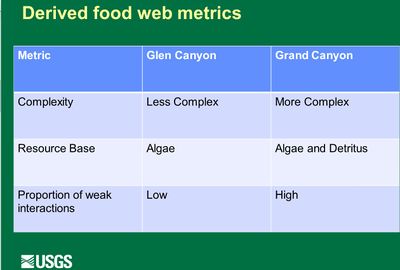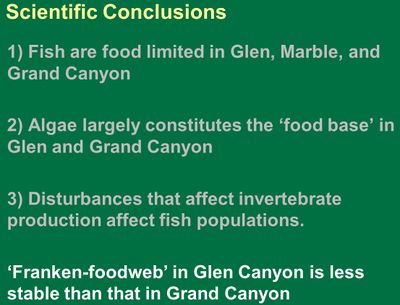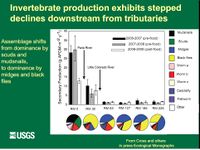Difference between revisions of "FOOD BASE"
Cellsworth (Talk | contribs) |
Cellsworth (Talk | contribs) |
||
| Line 81: | Line 81: | ||
2016 | 2016 | ||
*'''[http://www.usbr.gov/uc/rm/amp/twg/mtgs/16jan26/documents/AR16_Muehlbauer.pdf/ Food availability in the Little Colorado River over space and time]''' | *'''[http://www.usbr.gov/uc/rm/amp/twg/mtgs/16jan26/documents/AR16_Muehlbauer.pdf/ Food availability in the Little Colorado River over space and time]''' | ||
| − | *''' | + | *'''A Life History Bottleneck for Aquatic Insects Arising from Load Following''' |
| + | |||
| + | 2015 | ||
| + | *'''[http://www.usbr.gov/uc/rm/amp/twg/mtgs/15jan20/Attach_11.pdf/ Invertebrate drift in Glen Canyon 2007-2013]''' | ||
| + | |||
2013 | 2013 | ||
| − | *'''[http://www.gcmrc.gov/about/foodbase/Cross%20et%20al._EM_2013.pdf/ | + | *'''[http://www.gcmrc.gov/about/foodbase/Cross%20et%20al._EM_2013.pdf/ Food-web dynamics in a large river discontinuum]''' |
| + | *'''[http://pubs.usgs.gov/fs/2013/3039/fs2013-3039.pdf/ Native and nonnative fish populations of the Colorado River are food limited - Evidence from new food web analyses]''' | ||
| + | *'''[http://www.gcmrc.gov/about/foodbase/WellardKelley_et%20al.%202013.pdf/ Macroinvertebrate diets reflect tributary inputs and turbidity-driven changes in food availability in the Colorado River downstream of Glen Canyon Dam]''' | ||
| + | *'''[http://www.gcmrc.gov/about/foodbase/Kennedy%20et%20al.%20FWB%20proofs.pdf/ The relation between invertebrate drift and two primary controls, discharge and benthic densities, in a large | ||
| + | regulated river]''' | ||
| + | |||
| + | 2012 | ||
| + | *'''[http://www.gcmrc.gov/about/foodbase/Cross%20et%20al.%202011_EA.pdf/ Ecosystem ecology meets adaptive management: food web response to a controlled flood on the Colorado River, Glen Canyon]''' | ||
| + | *'''[http://www.gcmrc.gov/about/foodbase/Hall%20et%20al.%202012.pdf/ Air –water oxygen exchange in a large whitewater river]''' | ||
| + | |||
| + | 2011 | ||
| + | *'''http://www.gcmrc.gov/about/foodbase/Cross%20et%20al.%202011_EA.pdf/ Ecosystem ecology meets adaptive management: food web response to a controlled flood on the Colorado River, Glen Canyon]''' | ||
| + | *'''[http://www.gcmrc.gov/about/foodbase/Donner_Thesis%202011.pdf/ SECONDARY PRODUCTION RATES, CONSUMPTION RATES, AND TROPHIC 20 BASIS OF PRODUCTION OF FISHES IN THE COLORADO RIVER, GRAND CANYON, AZ: AN ASSESSMENT OF POTENTIAL COMPETITION FOR FOOD]''' | ||
| + | *'''[http://http://www.gcmrc.gov/about/foodbase/Zahn_Thesis_2011.pdf/ DIET OVERLAP AND COMPETITION AMONG NATIVE AND NON-NATIVE SMALL-BODIED FISHES IN THE COLORADO RIVER, GRAND CANYON, ARIZONA]''' | ||
| + | |||
| + | 2010 | ||
| + | *'''[http://www.gcmrc.gov/about/foodbase/Wellard%20Kelly_Thesis%202010.pdf/ RESOURCE COMPOSITION AND MACROINVERTEBRATE RESOURCE CONSUMPTION IN THE COLORADO RIVER BELOW GLEN CANYON DAM]''' | ||
| + | *'''[http://pubs.usgs.gov/of/2010/1031/of2010-1031.pdf/ Short-Term Effects of the 2008 High-Flow Experiment on Macroinvertebrates in Colorado River Below Glen Canyon Dam, Arizona]''' | ||
| + | *'''[http://pubs.usgs.gov/of/2010/1075/of2010-1075.pdf/ Basal Resources in Backwaters of the Colorado River Below Glen Canyon Dam—Effects of Discharge Regimes and Comparison with Mainstem Depositional Environments]''' | ||
| + | *'''[http://www.gcmrc.gov/about/foodbase/Hall%20et%20al.%20from%20sir2010-5135.pdf/ Aquatic production and carbon flow in the Colorado River Pages 105-112 in Proceedings of the Colorado River Basin Science and Resource Management Symposium, November 18–20, 2008, Scottsdale, Arizona]''' | ||
| + | *'''[http://www.gcmrc.gov/about/foodbase/Cross%20et%20al.%202010.pdf/ Invasion and production of New Zealand mud snails in the Colorado River, Glen Canyon]''' | ||
| + | |||
| + | |||
| + | |||
|- | |- | ||
! <h2 style="margin:0; background:#cedff2; font-size:120%; font-weight:bold; border:1px solid #a3b0bf; text-align:left; color:#000; padding:0.2em 0.4em;">Other Stuff</h2> | ! <h2 style="margin:0; background:#cedff2; font-size:120%; font-weight:bold; border:1px solid #a3b0bf; text-align:left; color:#000; padding:0.2em 0.4em;">Other Stuff</h2> | ||
Revision as of 16:02, 15 April 2016
|
|
Food Base USGS- GCMRC DefinitionThe Colorado River below Glen Canyon Dam has been altered by dam-induced modifications to the river’s flow, temperature, and sediment supply. Nonnative species have also changed the natural system. Nonnative fish are thought to prey on and compete with native fish, including the endangered humpback chub (Gila cypha). These impacts have likely changed both the amount and sources of energy that fuel the aquatic food web and the flows of energy within the food web. Installation of the dam created a relatively clear, cool aquatic environment below the dam that now allows aquatic plants to capture the sun’s energy, and they in turn are now consumed by a few species, including scuds (Gammarus lacustris), midges (Family: Chironomidae), blackflies (Simulium arcticum), and New Zealand mudsnails (Potamopyrgus antipodarum). The first three species can provide food for both native and nonnative fishes, but fish cannot digest the New Zealand mudsnail.
|
| TBD (Motions) |
TBD (TBD) |
TBD (TBD) |
|---|



